Long-Term Divergence in Green Exposure Trajectories and Economic Determinants in Urban China
Abstract
1. Introduction
2. Data Sources
2.1. Satellite Imagery for Green Space Extraction
2.2. Urban Boundaries
2.3. Socioeconomic Data
3. Methods
3.1. Green Space Extraction and Exposure Modeling
3.2. Spatiotemporal Analysis
3.3. Causal Inference Methods
3.4. Inequality Measures
4. Results
4.1. Spatiotemporal Distribution of Urban Green Space Coverage and Exposure
4.2. Causal Interaction Between Economic Development and Green Exposure
4.3. Spatial Coupling of Environmental and Economic Inequality
5. Discussion
5.1. Interpretations of Green Exposure Inequaltiy in China
5.2. Limitations
5.3. Policy Implications and Future Work
6. Conclusions
Supplementary Materials
Author Contributions
Funding
Data Availability Statement
Acknowledgments
Conflicts of Interest
References
- Argüeso, D.; Evans, J.P.; Pitman, A.J.; Di Luca, A. Effects of city expansion on heat stress under climate change conditions. PLoS ONE 2015, 10, e0117066. [Google Scholar] [CrossRef]
- Marlier, M.E.; Jina, A.S.; Kinney, P.L.; DeFries, R.S. Extreme air pollution in global megacities. Curr. Clim. Change Rep. 2016, 2, 15–27. [Google Scholar] [CrossRef]
- Li, G.; Fang, C.; Li, Y.; Wang, Z.; Sun, S.; He, S.; Qi, W.; Bao, C.; Ma, H.; Fan, Y.; et al. Global impacts of future urban expansion on terrestrial vertebrate diversity. Nat. Commun. 2022, 13, 1628. [Google Scholar] [CrossRef] [PubMed]
- Bu, F.; Mahmoud, H.A.; Alzoubi, H.M.; Ramazanovna, N.K.; Gao, Y. Do financial inclusion, natural resources and urbanization affect the sustainable environment in emerging economies. Resour. Policy 2023, 87, 104292. [Google Scholar] [CrossRef]
- Chen, W.; Wang, G.; Zeng, J. Impact of urbanization on ecosystem health in Chinese urban agglomerations. Environ. Impact Assess. Rev. 2023, 98, 106964. [Google Scholar] [CrossRef]
- Herath, P.; Bai, X. Benefits and co-benefits of urban green infrastructure for sustainable cities: Six current and emerging themes. Sustain. Sci. 2024, 19, 1039–1063. [Google Scholar] [CrossRef]
- Lin, B.B.; Egerer, M.H. Global social and environmental change drives the management and delivery of ecosystem services from urban gardens: A case study from Central Coast, California. Glob. Environ. Change 2020, 60, 102006. [Google Scholar] [CrossRef]
- Paudel, S.; States, S.L. Urban green spaces and sustainability: Exploring the ecosystem services and disservices of grassy lawns versus floral meadows. Urban For. Urban Green. 2023, 84, 127932. [Google Scholar] [CrossRef]
- Yang, X.; Duan, C.; Chen, B.; Wang, H. socio-economic value of urban green spaces in mitigating waterlogging and enhancing well-being. Resour. Conserv. Recycl. 2025, 212, 108010. [Google Scholar] [CrossRef]
- Lorenzo-Sáez, E.; Lerma-Arce, V.; Coll-Aliaga, E.; Oliver-Villanueva, J.V. Contribution of green urban areas to the achievement of SDGs. Case study in Valencia (Spain). Ecol. Indic. 2021, 131, 108246. [Google Scholar] [CrossRef]
- Xiong, J.; Yue, W.; Xia, H.; Wang, T.; Liu, Y.; Pijanowski, B.C. Will China’s territorial spatial planning policies enhance land use sustainability? An integrated assessment under global environmental change. Resour. Environ. Sustain. 2025, 21, 100228. [Google Scholar] [CrossRef]
- Guo, Y.; Yang, L.; Wang, L.; Li, H.; Ge, Q. Assessment of ecological civilization construction from the perspective of environment and health in China. Eco-Environ. Health 2024, 3, 281–289. [Google Scholar] [CrossRef]
- Ji, J.S.; Tao, Z.; Miao, H.; Cole-Hunter, T.; Li, X.; Rojas-Rueda, D.; Cai, W. Greenness and averted mortality in 390 cities in China (2000–2020). Lancet Reg. Health–West. Pac. 2025, 54, 101283. [Google Scholar] [CrossRef] [PubMed]
- Wang, C.; Liu, Y.; Chen, J.; Yu, C. Turning points of the relationship between human activity and environmental quality in China. Sustain. Cities Soc. 2025, 119, 106123. [Google Scholar] [CrossRef]
- Xu, Z.; Zhang, Z.; Li, C. Exploring urban green spaces in China: Spatial patterns, driving factors and policy implications. Land Use Policy 2019, 89, 104249. [Google Scholar] [CrossRef]
- Zhou, Q.; van den Bosch, C.C.K.; Chen, Z.; Wang, X.; Zhu, L.; Chen, J.; Lin, Y.; Dong, J. China’s Green space system planning: Development, experiences, and characteristics. Urban For. Urban Green. 2021, 60, 127017. [Google Scholar] [CrossRef]
- Chen, Y.; La Rosa, D.; Yue, W. Does urban sprawl lessen green space exposure? Evidence from Chinese cities. Landsc. Urban Plan. 2025, 257, 105319. [Google Scholar] [CrossRef]
- Huang, Y.; Lin, T.; Zhang, G.; Jones, L.; Xue, X.; Ye, H.; Liu, Y. Spatiotemporal patterns and inequity of urban green space accessibility and its relationship with urban spatial expansion in China during rapid urbanization period. Sci. Total Environ. 2022, 809, 151123. [Google Scholar] [CrossRef]
- Chen, B.; Tu, Y.; Wu, S.; Song, Y.; Jin, Y.; Webster, C.; Xu, B.; Gong, P. Beyond green environments: Multi-scale difference in human exposure to greenspace in China. Environ. Int. 2022, 166, 107348. [Google Scholar] [CrossRef]
- Boulton, C.; Dedekorkut-Howes, A.; Byrne, J. Factors shaping urban greenspace provision: A systematic review of the literature. Landsc. Urban Plan. 2018, 178, 82–101. [Google Scholar] [CrossRef]
- Rambhia, M.; Volk, R.; Rismanchi, B.; Winter, S.; Schultmann, F. Prioritizing urban green spaces in resource constrained scenarios. Resour. Environ. Sustain. 2024, 16, 100150. [Google Scholar] [CrossRef]
- Ai, H.; Zhou, Z. Inhibit or promote: The inverse-U-shape effect of greenspace on economic growth. Environ. Impact Assess. Rev. 2023, 100, 107094. [Google Scholar] [CrossRef]
- Wu, L.; Kim, S.K. Does socioeconomic development lead to more equal distribution of green space? Evidence from Chinese cities. Sci. Total Environ. 2021, 757, 143780. [Google Scholar] [CrossRef]
- Bockarjova, M.; Botzen, W.J.W.; Van Schie, M.H.; Koetse, M.J. Property price effects of green interventions in cities: A meta-analysis and implications for gentrification. Environ. Sci. Policy 2020, 112, 293–304. [Google Scholar] [CrossRef]
- Jiang, X.; Fu, W.; Li, G. Can the improvement of living environment stimulate urban innovation?—Analysis of high-quality innovative talents and foreign direct investment spillover effect mechanism. J. Clean. Prod. 2020, 255, 120212. [Google Scholar] [CrossRef]
- Heo, S.; Nori-Sarma, A.; Kim, S.; Lee, J.T.; Bell, M.L. Do persons with low socioeconomic status have less access to greenspace? Application of accessibility index to urban parks in Seoul, South Korea. Environ. Res. Lett. 2021, 16, 084027. [Google Scholar] [CrossRef]
- Wu, S.; Chen, B.; Webster, C.; Xu, B.; Gong, P. Improved human greenspace exposure equality during 21st century urbanization. Nat. Commun. 2023, 14, 6460. [Google Scholar] [CrossRef] [PubMed]
- Chen, J.; Kinoshita, T.; Li, H.; Luo, S.; Su, D. Which green is more equitable? A study of urban green space equity based on morphological spatial patterns. Urban For. Urban Green. 2024, 91, 128178. [Google Scholar] [CrossRef]
- Chen, B.; Wu, S.; Song, Y.; Webster, C.; Xu, B.; Gong, P. Contrasting inequality in human exposure to greenspace between cities of Global North and Global South. Nat. Commun. 2022, 13, 4636. [Google Scholar] [CrossRef] [PubMed]
- Li, X.; Gong, P.; Zhou, Y.; Wang, J.; Bai, Y.; Chen, B.; Hu, T.; Xiao, Y.; Xu, B.; Yang, J.; et al. Mapping global urban boundaries from the global artificial impervious area (GAIA) data. Environ. Res. Lett. 2020, 15, 094044. [Google Scholar] [CrossRef]
- Gong, P.; Li, X.; Wang, J.; Bai, Y.; Chen, B.; Hu, T.; Liu, X.; Xu, B.; Yang, J.; Zhang, W.; et al. Annual maps of global artificial impervious area (GAIA) between 1985 and 2018. Remote Sens. Environ. 2020, 236, 111510. [Google Scholar] [CrossRef]
- Stevens, F.R.; Gaughan, A.E.; Linard, C.; Tatem, A.J. Disaggregating census data for population mapping using random forests with remotely-sensed and ancillary data. PLoS ONE 2015, 10, e0107042. [Google Scholar] [CrossRef] [PubMed]
- Bille, R.A.; Jensen, K.E.; Buitenwerf, R. Global patterns in urban green space are strongly linked to human development and population density. Urban For. Urban Green. 2023, 86, 127980. [Google Scholar] [CrossRef]
- Wang, X.; Xiao, J.; Li, X.; Cheng, G.; Ma, M.; Zhu, G.; Arain, M.A.; Black, T.A.; Jassal, R.S. No trends in spring and autumn phenology during the global warming hiatus. Nat. Commun. 2019, 10, 2389. [Google Scholar] [CrossRef] [PubMed]
- Zhang, X.; Chen, J.; Wang, H.; Yang, D. From policy synergy to equitable greenspace: Unveiling the multifaceted effects of regional cooperation upon urban greenspace exposure inequality in China’s megacity-regions. Appl. Geogr. 2025, 174, 103472. [Google Scholar] [CrossRef]
- Gu, Y.; Wu, Y.; Liu, J.; Xu, M.; Zuo, T. Ecological civilization and government administrative system reform in China. Resour. Conserv. Recycl. 2020, 155, 104654. [Google Scholar] [CrossRef]
- Yu, Z.; Ma, W.; Hu, S.; Yao, X.; Yang, G.; Yu, Z.; Jiang, B. A simple but actionable metric for assessing inequity in resident greenspace exposure. Ecol. Indic. 2023, 153, 110423. [Google Scholar] [CrossRef]
- Yan, F.; Pang, J.; Liu, Y.; An, X.; Wang, X.; Liu, X.; Shen, L.; Chen, Y. Quantification and sensitivity assessment of Chinese provincial ecological compensation in the perspective of carbon deficit redistribution. Sci. Rep. 2024, 14, 22547. [Google Scholar] [CrossRef]
- Pradhan, K.; Rajabifard, A.; Aryal, J.; Crompvoets, J. Dissecting multidimensional morphology of urban sprawl: Framework for policy intervention. Cities 2025, 157, 105627. [Google Scholar] [CrossRef]
- Wang, B.; Wang, Y.; Wu, X. Impact of land use compactness on the habitat services from green infrastructure in Wuhan, China. Urban For. Urban Green. 2023, 84, 127927. [Google Scholar] [CrossRef]
- Haaland, C.; van Den Bosch, C.K. Challenges and strategies for urban green-space planning in cities undergoing densification: A review. Urban For. Urban Green. 2015, 14, 760–771. [Google Scholar] [CrossRef]
- Lin, B.; Meyers, J.; Barnett, G. Understanding the potential loss and inequities of green space distribution with urban densification. Urban For. Urban Green. 2015, 14, 952–958. [Google Scholar] [CrossRef]
- Fan, P.; Xu, L.; Yue, W.; Chen, J. Accessibility of public urban green space in an urban periphery: The case of Shanghai. Landsc. Urban Plan. 2017, 165, 177–192. [Google Scholar] [CrossRef]
- Bakhtsiyarava, M.; Moran, M.; Ju, Y.; Zhou, Y.; Rodriguez, D.A.; Dronova, I.; de Pina, M.d.F.R.P.; de Matos, V.P.; Skaba, D.A. Potential drivers of urban green space availability in Latin American cities. Nat. Cities 2024, 1, 842–852. [Google Scholar] [CrossRef]
- Hamza, M.; Edwards, R.C.; Beaumont, J.D.; De Pretto, L.; Torn, A. Access to natural green spaces and their associations with psychological wellbeing for South Asian people in the UK: A systematic literature review. Soc. Sci. Med. 2024, 359, 117265. [Google Scholar] [CrossRef]
- Wang, H.; Li, W.; Xiao, H.; Wang, D. Horizontal ecological compensation and urban inclusive green growth: Evidence from China. Front. Public Health 2024, 12, 1415309. [Google Scholar] [CrossRef] [PubMed]
- Twohig-Bennett, C.; Jones, A. The health benefits of the great outdoors: A systematic review and meta-analysis of greenspace exposure and health outcomes. Environ. Res. 2018, 166, 628–637. [Google Scholar] [CrossRef] [PubMed]
- Li, Y.; Svenning, J.-C.; Zhou, W.; Zhu, K.; Abrams, J.F.; Lenton, T.M.; Ripple, W.J.; Yu, Z.; Teng, S.N.; Dunn, R.R.; et al. Green spaces provide substantial but unequal urban cooling globally. Nat. Commun. 2024, 15, 7108. [Google Scholar] [CrossRef]
- Przewoźna, P.; Inglot, A.; Mielewczyk, M.; Mączka, K.; Matczak, P. Accessibility to urban green spaces: A critical review of WHO recommendations in the light of tree-covered areas assessment. Ecol. Indic. 2024, 166, 112548. [Google Scholar] [CrossRef]
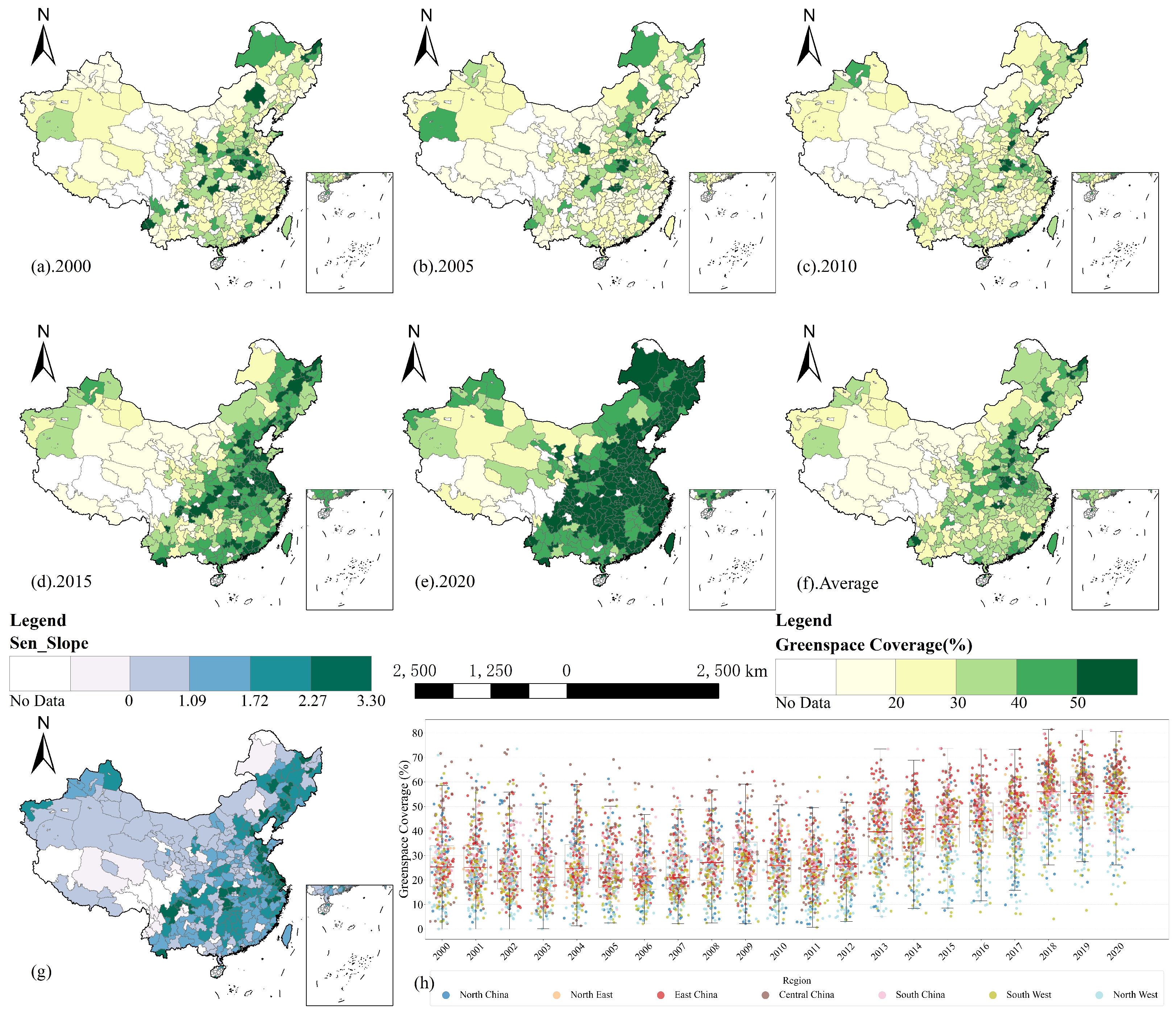
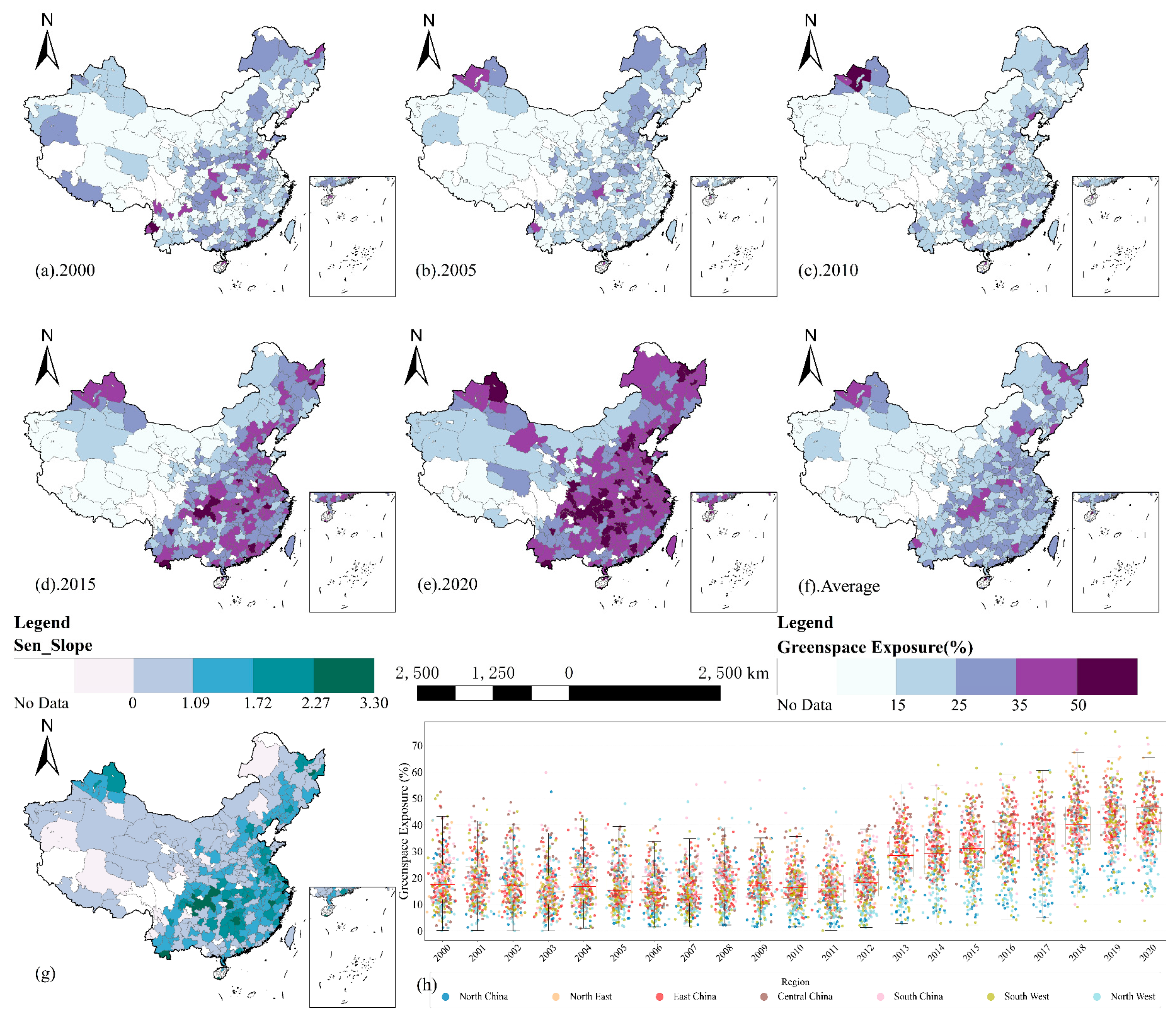
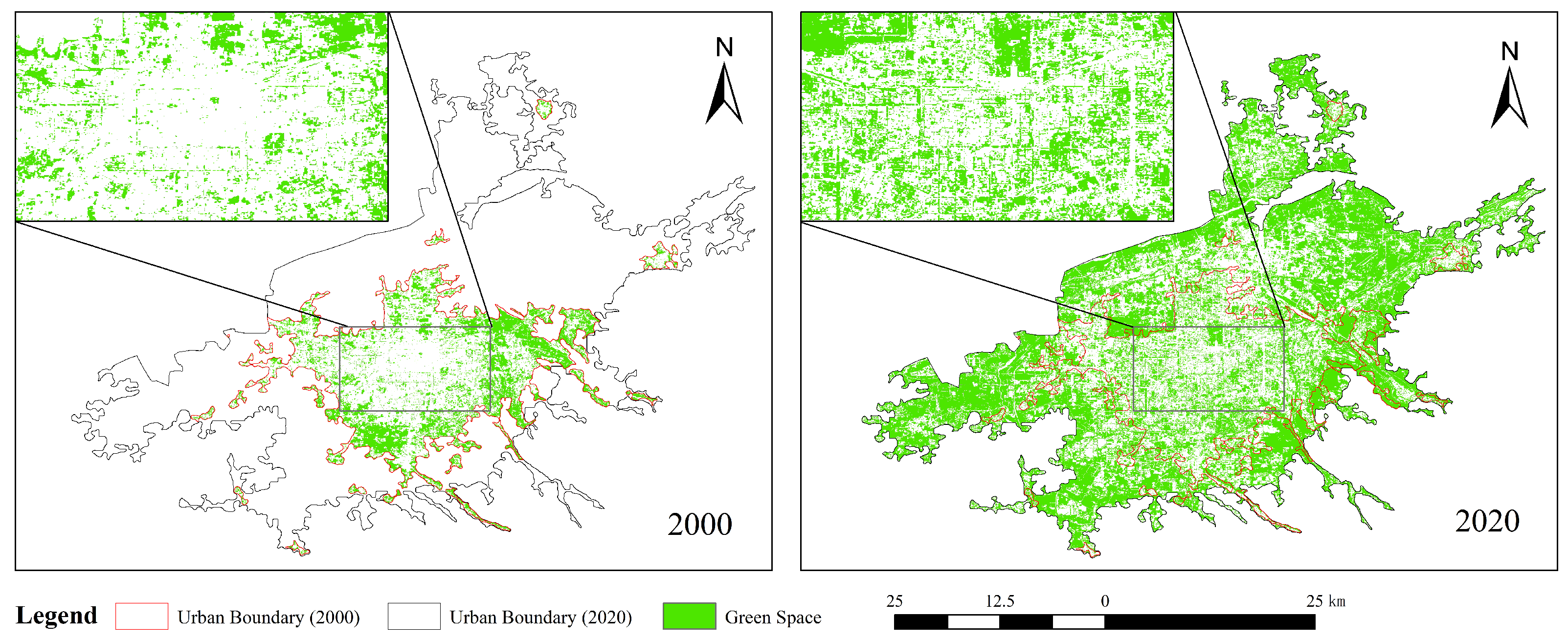
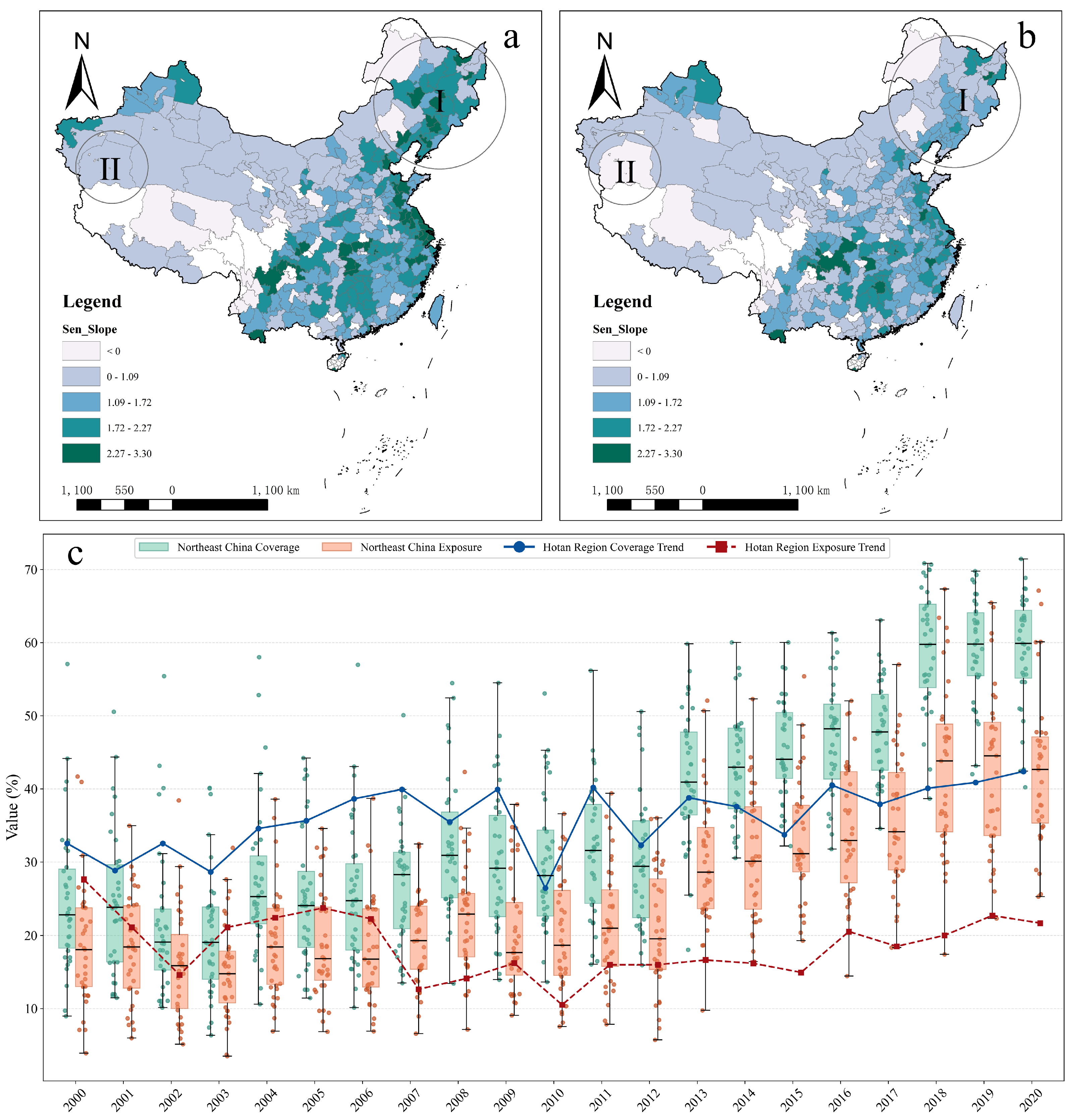
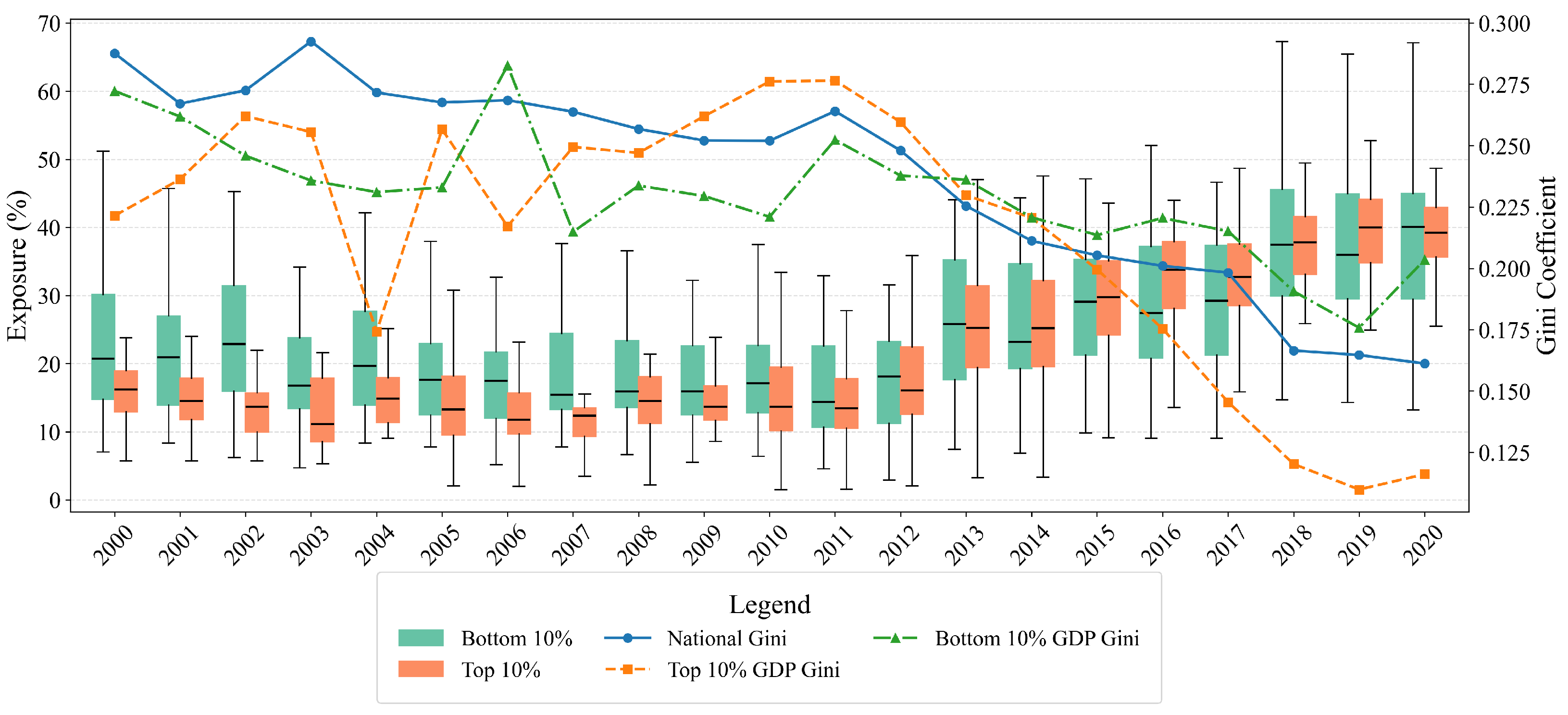
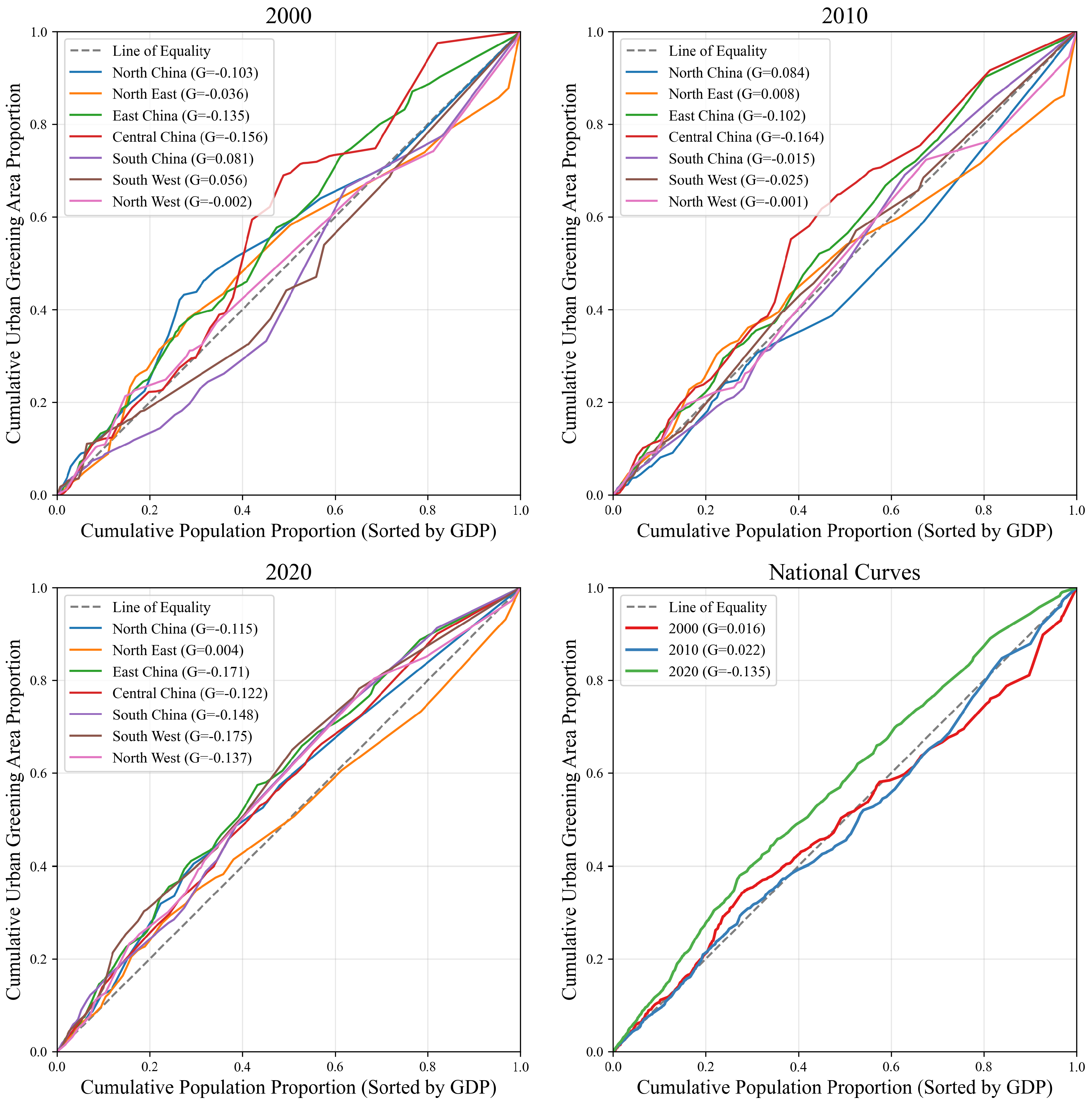
| Region | Null Hypothesis | F-Statistic | p-Value |
|---|---|---|---|
| China | Δ ln(AGDP) → Δ ln(UGR) | 25.014 | 0.000 *** |
| Δ ln(UGR) → Δ ln(AGDP) | 19.118 | 0.000 *** | |
| East China | Δ ln(AGDP) → Δ ln(UGR) | 9.167 | 0.000 *** |
| Δ ln(UGR) → Δ ln(AGDP) | 13.313 | 0.000 *** | |
| Central China | Δ ln(AGDP) → Δ ln(UGR) | 8.633 | 0.000 *** |
| Δ ln(UGR) → Δ ln(AGDP) | 6.262 | 0.000 *** | |
| South West | Δ ln(AGDP) → Δ ln(UGR) | 2.065 | 0.084 * |
| Δ ln(UGR) → Δ ln(AGDP) | 2.448 | 0.045 ** | |
| South China | Δ ln(AGDP) → Δ ln(UGR) | 1.248 | 0.289 |
| Δ ln(UGR) → Δ ln(AGDP) | 2.945 | 0.020 ** | |
| North China | Δ ln(AGDP) → Δ ln(UGR) | 1.629 | 0.165 |
| Δ ln(UGR)→Δ ln(AGDP) | 1.777 | 0.132 | |
| North East | Δ ln(AGDP)→Δ ln(UGR) | 5.206 | 0.000 *** |
| Δ ln(UGR)→Δ ln(AGDP) | 3.647 | 0.006 *** | |
| North West | Δ ln(AGDP)→Δ ln(UGR) | 2.777 | 0.026 ** |
| Δ ln(UGR)→Δ ln(AGDP) | 1.331 | 0.257 |
| Region | Null Hypothesis | Coefficient |
|---|---|---|
| China | Δ ln(AGDP) → Δ ln(UGR) | 0.31 *** |
| Δ ln(UGR) → Δ ln(AGDP) | 0.436 *** | |
| East China | Δ ln(AGDP) → Δ ln(UGR) | 0.308 *** |
| Δ ln(UGR) → Δ ln(AGDP) | 0.576 *** | |
| Central China | Δ ln(AGDP) → Δ ln(UGR) | 0.449 *** |
| Δ ln(UGR) → Δ ln(AGDP) | 0.473 *** | |
| South West | Δ ln(AGDP) → Δ ln(UGR) | 0.324 *** |
| Δ ln(UGR) → Δ ln(AGDP) | 0.465 *** | |
| South China | Δ ln(AGDP) → Δ ln(UGR) | 0.18 *** |
| Δ ln(UGR) → Δ ln(AGDP) | 0.377 *** | |
| North China | Δ ln(AGDP) → Δ ln(UGR) | 0.195 *** |
| Δ ln(UGR) → Δ ln(AGDP) | 0.192 *** | |
| North East | Δ ln(AGDP) → Δ ln(UGR) | 0.29 *** |
| Δ ln(UGR) → Δ ln(AGDP) | 0.309 *** | |
| North West | Δ ln(AGDP) → Δ ln(UGR) | 0.323 *** |
| Δ ln(UGR) → Δ ln(AGDP) | 0.45 *** |
Disclaimer/Publisher’s Note: The statements, opinions and data contained in all publications are solely those of the individual author(s) and contributor(s) and not of MDPI and/or the editor(s). MDPI and/or the editor(s) disclaim responsibility for any injury to people or property resulting from any ideas, methods, instructions or products referred to in the content. |
© 2025 by the authors. Licensee MDPI, Basel, Switzerland. This article is an open access article distributed under the terms and conditions of the Creative Commons Attribution (CC BY) license (https://creativecommons.org/licenses/by/4.0/).
Share and Cite
Liu, R.; Zhang, P.; Zhou, G.; Li, X.; Zhang, D.; Liu, M. Long-Term Divergence in Green Exposure Trajectories and Economic Determinants in Urban China. Sustainability 2025, 17, 9345. https://doi.org/10.3390/su17209345
Liu R, Zhang P, Zhou G, Li X, Zhang D, Liu M. Long-Term Divergence in Green Exposure Trajectories and Economic Determinants in Urban China. Sustainability. 2025; 17(20):9345. https://doi.org/10.3390/su17209345
Chicago/Turabian StyleLiu, Renpeng, Peng Zhang, Gaoxiang Zhou, Xinbin Li, Dedong Zhang, and Ming Liu. 2025. "Long-Term Divergence in Green Exposure Trajectories and Economic Determinants in Urban China" Sustainability 17, no. 20: 9345. https://doi.org/10.3390/su17209345
APA StyleLiu, R., Zhang, P., Zhou, G., Li, X., Zhang, D., & Liu, M. (2025). Long-Term Divergence in Green Exposure Trajectories and Economic Determinants in Urban China. Sustainability, 17(20), 9345. https://doi.org/10.3390/su17209345







